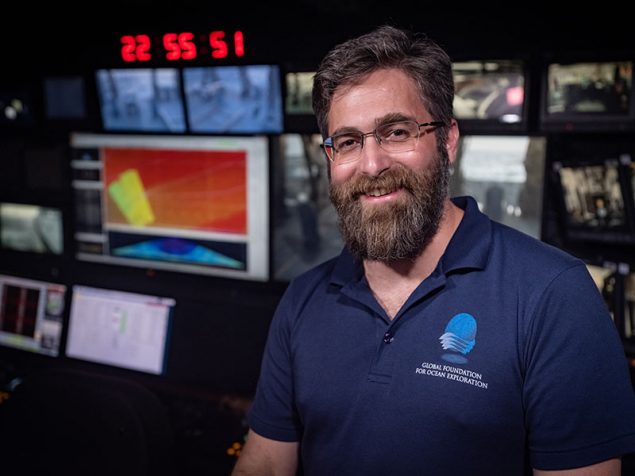
The down low—what is your role on the ship?
When I’m aboard the Okeanos Explorer I am a leader in GFOE’s software development, data management, and computing efforts. I am also qualified to stand ROV related watches, including the roles of ROV pilot, copilot, and navigator, and as winch operator and launch and recovery deck team member. I generally start my day by checking the data acquisition systems. To collect and transmit the data we send to shore, it takes hundreds of networked devices working in concert. Occasionally issues arise and it helps to get a jump on things first thing in the morning to ensure they don’t impact the dive. After that, when I’m not standing watch, I will be working on data and software projects. When I’m not on the Okeanos, I deploy to other vessels, and work on autonomous vehicle development.
My job is like an interactive Blue Planet movie—I get to design, build, and operate multi-million dollar robots that take humanity places we’ve never gone before. If I was independently wealthy I would be spending my money to do this. Ultimately, I hope to build tools that make science less difficult.

How did you get here?
I grew up on the East Coast, primarily Connecticut and Pennsylvania. I have to admit that I was a bit of a troublemaker and didn’t perform very well in school. I really didn’t have any career aspirations other than I wanted to do something I enjoyed even if it wasn’t lucrative. After high school I joined the Navy with two goals: to ease the financial burden of attending college on my family, and to prove (to myself) that I deserved to go. I choose to pursue Electronics Technician training because it was reputed to be one of the most difficult. One would think there was a natural progression from the Navy to the Okeanos, but in my eight years in the Navy I never sailed on a ship. Instead I worked on shore communications equipment before ultimately serving as a Satellite Communications Instructor with NATO. During this time I started to tinker with computers, though I never believed I could program one.
After the Navy, I started college with the intention of becoming a history teacher—I really enjoyed instructing and thought I was good at it—but I felt I owed it to my computer hobby to at least try to program one. I took a bunch of math and computer science classes and surprised myself by succeeding in them. So much so, that after I completed my bachelor’s in history I was offered an assistantship to pursue a master’s in computer science. In graduate school I realized I was most interested in robotics, as it’s a direct path for your software to influence the world. It is still very satisfying to see your robot behave as you intend! As I completed my degree, I learned of a small company near where I lived in Vermont that developed custom ROV control systems and I was overjoyed to start. During my time with this company, I developed a wide range of vehicles (one was an underwater vehicle that launched a helicopter that launched a plane!) including NOAA’s Deep Discoverer and Seirios ROVs. This introduced me to the absolutely amazingly talented GFOE engineering team and our work on the Okeanos.
A parting thought: Choose to love what you do and everything else will follow.

